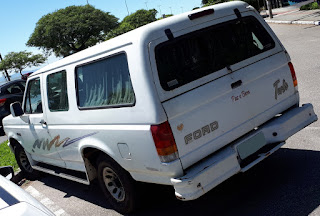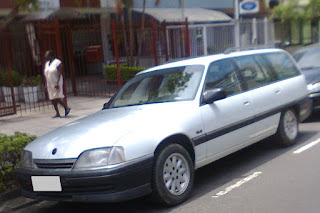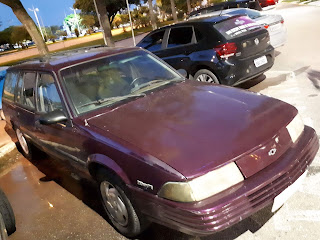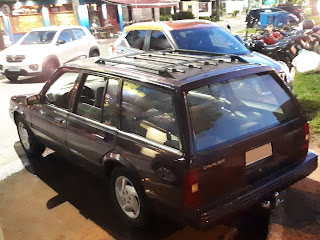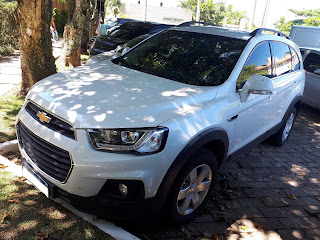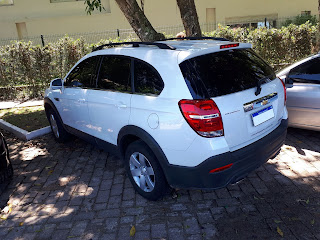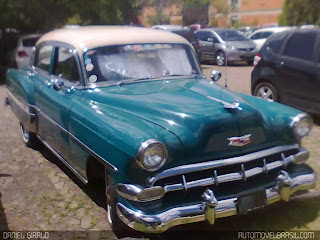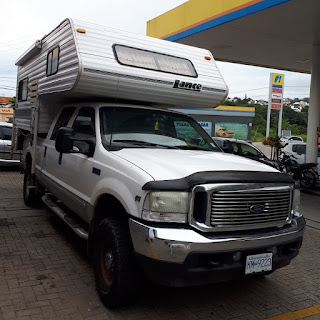Pick-up trucks with some sort of SUV-type conversion used to be quite popular in Brazil at least until the late-'90s, with examples from that time still roaming around once in a while. Used not only by the public institutions for the most diverse roles such as ambulances and police vehicles, they also had its share of the market among the general public. It may seem at a first glance similar to the Ford Bronco Centurion Classic, a 4-door conversion which was done in the United States based on both the F-150 and F-350 to fill the gap left on the Ford domestic range by the absence of a long-wheelbase 4-door variant for the Bronco, even though this Brazilian Ford F-1000 has the short wheelbase of the F-150 regular-cab short-bed with a payload and GVWR closer to what a F-250 would be slotted into. With a wheel arch reaching the rear door on the right, it's easier to figure out it has a shorter wheelbase than its American counterparts which were based on a factory double-cab configuration which hasn't been officially available in Brazil during the production cycle of this generation of full-size Ford trucks.
Besides the unusual 3-door layout more associated with vans, another aspect to highlight is the much smaller engine fitted to this vehicle, a Maxion 2.5HS 4-cylinder turbodiesel made in Argentina. Only a 5-speed manual transmission and rear-wheel drive were available with this engine, while the larger 4.3L MWM 4.10 turbodiesel which also had a 4-cylinder layout had the 4-wheel drive as a standard feature for a while until it became the sole turbodiesel option for the last batch of the F-1000 in '98 when the smaller yet higher-revving Maxion quit being offered in the F-1000. The same model also used to be available in Argentina where it retained the F-100 badging as a matter of tradition, and similar bodyworks locally referred to as "F-100 carrozada" or "F-100 rural" were also available and usually made by Igarreta which owns a Ford dealership in Buenos Aires. To be honest, the 3-door layout of this F-1000 nearly led me to mistake it for an Argentinian F-100 carrozada rural conversion, since the older ones which I used to see more often in Brazil as private vehicles retained a 2-door configuration and some of this generation which were used as police vehicles had a 4-door layout.Sunday, February 23, 2020
Sunday, February 09, 2020
5 vehicles that could've been better served with the Chevrolet 153 engine
It's already known the Chevrolet 153 engine is among the most versatile powerplants ever made, and it could eventually retain some foothold in the new-car market at least in some regions with less strict emission rules given some technical updates such as multi-port fuel injection. But it had already been neglected long ago, with some models made by different GM divisions relying on other engine ranges even though the 153 could eventually fare somewhat better on them. At least 5 examples can be highlighted.
1 - Opel Omega A: originally released in Europe in '86 with 1.8L and 2.0L versions of the Family II and a 2.4L one of the ancient Opel Cam-In-Head (CIH) as the gasoline-powered 4-cyl versions, plus some straight-six 2.6L and 3.0L versions of the CIH and even some 4-cyl Diesel 2.3L derivatives of the CIH, it was discontinued there in '93 while this year also marked its introduction in Brazil where locally-made 2.0L versions of the Family II and a 3.0L CIH sourced from Germany were the initial engine options. Later on in '94, the Family II was enlarged to 2.2L while the CIH was discontinued and replaced by an updated version of the venerable Chevrolet 250cu.in. (4.1L) straight-six also made in Brazil. Considering both the 250.cu.in straight-six and the 4-cyl 153 share the same basic layout, it wouldn't seem so pointless to fit the 153 with multi-port fuel injection and other minor enhancements too, enabling its 2.5L versions which were the only ones made in Brazil to eventually serve better than the Family II.
2 - Chevrolet Cavalier: since it has relied on the 4-cyl 122 engine, and the 60-degree V6 as premium option, and both had a chain-driven OHV valvetrain, the 153 could've served eventually better due to the gear-driven valvetrain. With the 122 initially covering the 1.8L to 2.0L displacement range, being later enlarged to 2.2L at its final iteration, and the 60-degree V6 covering the 2.8L to 3.1L range in the Cavalier, the 153 which covered the 1.8L to 2.5L range in international automotive applications and up to 3.0L in stationary/industrial and marine ones in the United States, it wouldn't be a surprise if the 1.9L and 2.3L specifications which had been used by various models in South Africa could've fared well in the Cavalier, and even the 3.0L could make its way under the hood as a more affordable option than a V6 while also increasing pulling power...
3 - 2nd-generation Chevrolet S10: considering it had the 122-based Vortec 2200 as the base engine in the United States and a derivative of the Family II covering the same 2.2L displacement range in Brazil, the gear-driven valvetrain would've been more attractive to many commercial operators who value simpler engines for being less failure-prone, since it would eliminate the timing chain as used in the Vortec 2200 and the belt found on its Brazilian counterpart. It's worth to notice the 153 has been already a popular alternative for repowerings in Brazil, even though it's older than the local variants of the S10...
4 - Korean Chevrolet Captiva: considering this model had been targetted more toward Europe and emerging markets, where emission regulations may differ substantially, some upgraded version of the 153 could eventually seem more suitable to a few regions instead of being offered on all markets. In the gasoline-powered versions, the 2.4L displacement had been covered initially by the Family II and later by an Ecotec, while the High-Feature V6 was initially available at a 3.2L version with port injection later replaced by a 3.0L one with direct injection. Then it seems quite predictable the 153 could be a reasonable option, at least for some markets with a more budget-conscious profile where a seemingly-ancient engine design that could be made locally at a lower cost for fitment into CKD kits would be desirable.
5 - 1st-generation Chevrolet Cruze: it may sound weird to suggest such an ancient engine could've been great in one of the models that held an enormous importance during a GM worldwide recovery after the 2008 global crisis. Gasoline-powered options were either 1.6L or 1.8L naturally-aspirated, and a 1.4L turbocharged as the premium engine, with regional differences in the availability of each. In my homeland Brazil, for example, only a 1.8L flexfuel Ecotec was offered. Considering not only the manufacturing cost of the DOHC 16-valve engines, but also some maintenance issues and even political implications since in China there is a mandatory technology transfer to local companies, the cheap and dumbproof design of the 153 would've been desirable in some markets, as it would be able to cover at least the 1.8L displacement range or even grow bigger in markets where the displacement doesn't have the same relevance for the tax structure. Since the 153 used to be a mainstay for GM in South Africa until local engine manufacture was phased out in '82, which might be accountable as one of the factors that led to the demise of local operations entirely in late-2017, while in Thailand the same basic layout could be shared between smaller-displacement trims meant for compact cars and larger versions could cater to the truck range, the economics of scale would eventually justify the 153 due to fewer investments which could be required for tooling upgrades and the viability to extend its application to a large amount of models from different segments. When it comes to China, sharing only such an ancient engine design with the local partner would be more desirable since development costs have been already paid-off.
1 - Opel Omega A: originally released in Europe in '86 with 1.8L and 2.0L versions of the Family II and a 2.4L one of the ancient Opel Cam-In-Head (CIH) as the gasoline-powered 4-cyl versions, plus some straight-six 2.6L and 3.0L versions of the CIH and even some 4-cyl Diesel 2.3L derivatives of the CIH, it was discontinued there in '93 while this year also marked its introduction in Brazil where locally-made 2.0L versions of the Family II and a 3.0L CIH sourced from Germany were the initial engine options. Later on in '94, the Family II was enlarged to 2.2L while the CIH was discontinued and replaced by an updated version of the venerable Chevrolet 250cu.in. (4.1L) straight-six also made in Brazil. Considering both the 250.cu.in straight-six and the 4-cyl 153 share the same basic layout, it wouldn't seem so pointless to fit the 153 with multi-port fuel injection and other minor enhancements too, enabling its 2.5L versions which were the only ones made in Brazil to eventually serve better than the Family II.
2 - Chevrolet Cavalier: since it has relied on the 4-cyl 122 engine, and the 60-degree V6 as premium option, and both had a chain-driven OHV valvetrain, the 153 could've served eventually better due to the gear-driven valvetrain. With the 122 initially covering the 1.8L to 2.0L displacement range, being later enlarged to 2.2L at its final iteration, and the 60-degree V6 covering the 2.8L to 3.1L range in the Cavalier, the 153 which covered the 1.8L to 2.5L range in international automotive applications and up to 3.0L in stationary/industrial and marine ones in the United States, it wouldn't be a surprise if the 1.9L and 2.3L specifications which had been used by various models in South Africa could've fared well in the Cavalier, and even the 3.0L could make its way under the hood as a more affordable option than a V6 while also increasing pulling power...
3 - 2nd-generation Chevrolet S10: considering it had the 122-based Vortec 2200 as the base engine in the United States and a derivative of the Family II covering the same 2.2L displacement range in Brazil, the gear-driven valvetrain would've been more attractive to many commercial operators who value simpler engines for being less failure-prone, since it would eliminate the timing chain as used in the Vortec 2200 and the belt found on its Brazilian counterpart. It's worth to notice the 153 has been already a popular alternative for repowerings in Brazil, even though it's older than the local variants of the S10...
4 - Korean Chevrolet Captiva: considering this model had been targetted more toward Europe and emerging markets, where emission regulations may differ substantially, some upgraded version of the 153 could eventually seem more suitable to a few regions instead of being offered on all markets. In the gasoline-powered versions, the 2.4L displacement had been covered initially by the Family II and later by an Ecotec, while the High-Feature V6 was initially available at a 3.2L version with port injection later replaced by a 3.0L one with direct injection. Then it seems quite predictable the 153 could be a reasonable option, at least for some markets with a more budget-conscious profile where a seemingly-ancient engine design that could be made locally at a lower cost for fitment into CKD kits would be desirable.
5 - 1st-generation Chevrolet Cruze: it may sound weird to suggest such an ancient engine could've been great in one of the models that held an enormous importance during a GM worldwide recovery after the 2008 global crisis. Gasoline-powered options were either 1.6L or 1.8L naturally-aspirated, and a 1.4L turbocharged as the premium engine, with regional differences in the availability of each. In my homeland Brazil, for example, only a 1.8L flexfuel Ecotec was offered. Considering not only the manufacturing cost of the DOHC 16-valve engines, but also some maintenance issues and even political implications since in China there is a mandatory technology transfer to local companies, the cheap and dumbproof design of the 153 would've been desirable in some markets, as it would be able to cover at least the 1.8L displacement range or even grow bigger in markets where the displacement doesn't have the same relevance for the tax structure. Since the 153 used to be a mainstay for GM in South Africa until local engine manufacture was phased out in '82, which might be accountable as one of the factors that led to the demise of local operations entirely in late-2017, while in Thailand the same basic layout could be shared between smaller-displacement trims meant for compact cars and larger versions could cater to the truck range, the economics of scale would eventually justify the 153 due to fewer investments which could be required for tooling upgrades and the viability to extend its application to a large amount of models from different segments. When it comes to China, sharing only such an ancient engine design with the local partner would be more desirable since development costs have been already paid-off.
Saturday, February 08, 2020
5 vehicles whose lowest-grade engine is actually more interesting
Many aspects may lead to differences in the engine selection for some cars and trucks according to the market, such as emissions compliance, local content requirements and repurposing of an ancient engine in order to avoid investments on newer tooling to manufacture more advanced powerplants. Among those examples, at least 5 can be highlighted.
1 - early Volkswagen Voyage: this model, made exclusively in Brazil and Argentina, had a variety of other names according to the market, such as Gacel, Senda, Amazon, Amazonas and Fox as it was known in the United States and Canada. The most widely available engines in export markets were 1.6L and 1.8L versions of the EA827 engine, including a 1.6L Diesel version, however in Brazil there has been a 1.6L Ford-built CHT which is based on the Renault Cléon-Fonte engine. Underestimated due to the lack of aftermarket support for performance applications, it's still remarkable as a reliable engine, with features such as wet sleeves and the chain-driven OHV valvetrain also rendering it quite easy to overhaul.
2 - Dodge D-Series: at least until '65 in Argentina, the D-100 retained the Chrysler Flathead-Six as a base engine, even when the 318cu.in. (5.2L) LA V8 imported from Mexico was available. Later on it had the Flathead-Six replaced by the Slant-Six as the base engine. It's worth to notice in Argentina the V8 required the super gasoline, while both of its straight-6 counterparts could use regular, while in Brazil only the V8 was available and able to use regular gasoline. Perkins Diesel engines had also been available, first in Argentina with the 3.3L 4-203 and later in Brazil the 3.9L 4-236 was used instead.
3 - Fiat 147: considering the OHC valvetrain of the 1.05L and 1.3L Fiasa engines used in Brazil was plagued with timing belt failure issues, the versions assembled in Uruguay having been available with a 903cc spec of the OHV 100-series engine which resorted to a timing chain doesn't seem so wrong at all.
4 - Citroën Visa: besides the transversely-mounted straight-4 gasoline-powered or Diesel engines, it also had the longitudinally-mounted 652cc flat-twin based on the Citroën 2CV engine as the low-end option. Since this engine not only has fewer parts, but is also the only one with gear-driven valvetrain and air-cooling, had been favored not only by budget-conscious buyers who didn't wand the Diesel and became a favorite in some export markets where ease of maintenance was a matter of concern. No wonder in some countries such as Uruguay, it's easier to find either the flat-twin or the Diesel than any of the gasoline-powered straight-4 engines.
5 - Chevrolet GMT400 trucks: unarguably the Vortec 4300 V6 was the lowest-grade engine fitted to the GMT400 generation in North America, while during the Argentinian production run an updated version of the venerable 250cu.in. (4.1L) straight-six with multi-port fuel injection became the only gasoline-powered engine available, always backed by a 5-speed manual transmission and rear-wheel drive. Surprisingly, even the Brazilian-made S10 and the Blazer had the Vortec 4300 available by then, imported from the United States. Since the old-school straight-six still had a gear-driven valvetrain instead of a chain-driven one like the Vortec 4300, it wasn't a bad choice at all, even though the lack of options such as automatic transmission and 4-wheel drive rendered it uncompetitive.
1 - early Volkswagen Voyage: this model, made exclusively in Brazil and Argentina, had a variety of other names according to the market, such as Gacel, Senda, Amazon, Amazonas and Fox as it was known in the United States and Canada. The most widely available engines in export markets were 1.6L and 1.8L versions of the EA827 engine, including a 1.6L Diesel version, however in Brazil there has been a 1.6L Ford-built CHT which is based on the Renault Cléon-Fonte engine. Underestimated due to the lack of aftermarket support for performance applications, it's still remarkable as a reliable engine, with features such as wet sleeves and the chain-driven OHV valvetrain also rendering it quite easy to overhaul.
2 - Dodge D-Series: at least until '65 in Argentina, the D-100 retained the Chrysler Flathead-Six as a base engine, even when the 318cu.in. (5.2L) LA V8 imported from Mexico was available. Later on it had the Flathead-Six replaced by the Slant-Six as the base engine. It's worth to notice in Argentina the V8 required the super gasoline, while both of its straight-6 counterparts could use regular, while in Brazil only the V8 was available and able to use regular gasoline. Perkins Diesel engines had also been available, first in Argentina with the 3.3L 4-203 and later in Brazil the 3.9L 4-236 was used instead.
3 - Fiat 147: considering the OHC valvetrain of the 1.05L and 1.3L Fiasa engines used in Brazil was plagued with timing belt failure issues, the versions assembled in Uruguay having been available with a 903cc spec of the OHV 100-series engine which resorted to a timing chain doesn't seem so wrong at all.
4 - Citroën Visa: besides the transversely-mounted straight-4 gasoline-powered or Diesel engines, it also had the longitudinally-mounted 652cc flat-twin based on the Citroën 2CV engine as the low-end option. Since this engine not only has fewer parts, but is also the only one with gear-driven valvetrain and air-cooling, had been favored not only by budget-conscious buyers who didn't wand the Diesel and became a favorite in some export markets where ease of maintenance was a matter of concern. No wonder in some countries such as Uruguay, it's easier to find either the flat-twin or the Diesel than any of the gasoline-powered straight-4 engines.
5 - Chevrolet GMT400 trucks: unarguably the Vortec 4300 V6 was the lowest-grade engine fitted to the GMT400 generation in North America, while during the Argentinian production run an updated version of the venerable 250cu.in. (4.1L) straight-six with multi-port fuel injection became the only gasoline-powered engine available, always backed by a 5-speed manual transmission and rear-wheel drive. Surprisingly, even the Brazilian-made S10 and the Blazer had the Vortec 4300 available by then, imported from the United States. Since the old-school straight-six still had a gear-driven valvetrain instead of a chain-driven one like the Vortec 4300, it wasn't a bad choice at all, even though the lack of options such as automatic transmission and 4-wheel drive rendered it uncompetitive.
Thursday, February 06, 2020
5 vehicles that would be tempting to swap a Cummins R2.8 crate engine into
Even though some gasoline-powered (and occasionally flexfuel) small-block V8 remains as the most usual option for those looking for an engine swap in the United States, a serious contender appeared when Cummins released its R2.8 crate engine with an aim set specifically at the repowering market. Even though its horsepower rating may not seem so outstanding at a first glance, not to mention other aspects such as the perception of a higher amount of cylinders as a premium feature, it became in fact quite competitive and can serve reasonably nearly every vehicle to which a small-block V8 would be more frequently applied. Among so many vehicles which could be a good receiver for the Cummins R2.8 crate engine, some which could be highlighted are...
1 - Range Rover Sport: sure the R2.8 won't outperform the stock 3-litre Td6, not to mention the lack of emissions compliance and all the complexity to integrate the electronic control of the engine and the receiving vehicle's own systems, but it's by orders of magnitude simpler and easier to overhaul. Not the easiest to perform a R2.8 swap, yet still tempting to pick one with a shot engine and at least give it a try...
2 - early Chevrolet Bel-Air: prior to the Tri-Five generation for which the V8 became available as a highly-popular option, the straight-6 with a 4-bearing crankshaft usually referred to as Thriftmaster or Blue Flame depending on the version was the sole engine fitted to this model. Even thought the stock engine doesn't require a timing chain as the R2.8 does, the most common V8 swaps rely on one, plus the growing acceptance of EFI on gasoline engines retrofitted to classics may help debunking some objections to electronics in a turbodiesel...
3 - Jeep ZJ/ZG Grand Cherokee: one of the most common SUVs of the '90s, it relied solely on the AMC straight-6 and the Magnum V8 on both 318cu.in. (5.2L) and 360cu.in. (5.9L) versions for the USDM while the Euro-spec ZG assembled in Austria by Magna Steyr required the availability of the 2.5L VM Motori 425 OHV turbodiesel engine. Expecting some fuel-efficiency improvements against both the AMC straight-6 and the Magnum V8 is somewhat obvious, but when it comes to the VM it's quite compromised as much of the high-speed Diesel engines below 3-litre from the '80s through the '90s used to be and more unlikely to match the performance expectations of an average American.
4 - Nissan 350Z: probably one of the models for which the possibility of a Diesel swap would spark more controversy, not to mention the emissions non-compliance issue, but the R2.8 seems to be an easier fit than the B3.9 (a.k.a. 4BT) for which I considered the 350Z to be a good candidate for a swap by the time of its official release in my homeland Brazil.
5 - early Ford Super Duty: even though it was available with the 7.3L V8 PowerStroke turbodiesel as an option at the time of its introduction, later on came the controversial 6.0L which became known as the "six-leaker" and had a poor reliability record to which even the seemingly-underpowered R2.8 might appear tempting as a way to get rid of. Sure the emissions compliance issue would also affect this application, even though Cummins could release some upgraded versions more up-to-date on that regard in order to increase the suitability of the R2.8 at least up to the EPA-2007 rules.
On a sidenote, it's still worth to notice the R2.8 is more targetted towards replacing gasoline-powered engines, such as the Triton 5.4 V8 which had been the standard engine for the early F-350 Super Duty in the United States, Canada and Mexico. Brazil on the other hand used to be way more receptive to the 4-cylinder turbodiesel, with the local variants of the F-350 Super Duty and its DRW derivative F-4000 having initially being available with the Cummins B3.9 until their first phaseout in late-2011, to be reintroduced in 2014 with the ISF2.8 on which the R2.8 is based, to be ultimately phased out in 2019 when Ford got out of the truck market in South America.
1 - Range Rover Sport: sure the R2.8 won't outperform the stock 3-litre Td6, not to mention the lack of emissions compliance and all the complexity to integrate the electronic control of the engine and the receiving vehicle's own systems, but it's by orders of magnitude simpler and easier to overhaul. Not the easiest to perform a R2.8 swap, yet still tempting to pick one with a shot engine and at least give it a try...
2 - early Chevrolet Bel-Air: prior to the Tri-Five generation for which the V8 became available as a highly-popular option, the straight-6 with a 4-bearing crankshaft usually referred to as Thriftmaster or Blue Flame depending on the version was the sole engine fitted to this model. Even thought the stock engine doesn't require a timing chain as the R2.8 does, the most common V8 swaps rely on one, plus the growing acceptance of EFI on gasoline engines retrofitted to classics may help debunking some objections to electronics in a turbodiesel...
3 - Jeep ZJ/ZG Grand Cherokee: one of the most common SUVs of the '90s, it relied solely on the AMC straight-6 and the Magnum V8 on both 318cu.in. (5.2L) and 360cu.in. (5.9L) versions for the USDM while the Euro-spec ZG assembled in Austria by Magna Steyr required the availability of the 2.5L VM Motori 425 OHV turbodiesel engine. Expecting some fuel-efficiency improvements against both the AMC straight-6 and the Magnum V8 is somewhat obvious, but when it comes to the VM it's quite compromised as much of the high-speed Diesel engines below 3-litre from the '80s through the '90s used to be and more unlikely to match the performance expectations of an average American.
4 - Nissan 350Z: probably one of the models for which the possibility of a Diesel swap would spark more controversy, not to mention the emissions non-compliance issue, but the R2.8 seems to be an easier fit than the B3.9 (a.k.a. 4BT) for which I considered the 350Z to be a good candidate for a swap by the time of its official release in my homeland Brazil.
5 - early Ford Super Duty: even though it was available with the 7.3L V8 PowerStroke turbodiesel as an option at the time of its introduction, later on came the controversial 6.0L which became known as the "six-leaker" and had a poor reliability record to which even the seemingly-underpowered R2.8 might appear tempting as a way to get rid of. Sure the emissions compliance issue would also affect this application, even though Cummins could release some upgraded versions more up-to-date on that regard in order to increase the suitability of the R2.8 at least up to the EPA-2007 rules.
On a sidenote, it's still worth to notice the R2.8 is more targetted towards replacing gasoline-powered engines, such as the Triton 5.4 V8 which had been the standard engine for the early F-350 Super Duty in the United States, Canada and Mexico. Brazil on the other hand used to be way more receptive to the 4-cylinder turbodiesel, with the local variants of the F-350 Super Duty and its DRW derivative F-4000 having initially being available with the Cummins B3.9 until their first phaseout in late-2011, to be reintroduced in 2014 with the ISF2.8 on which the R2.8 is based, to be ultimately phased out in 2019 when Ford got out of the truck market in South America.
Subscribe to:
Comments (Atom)

